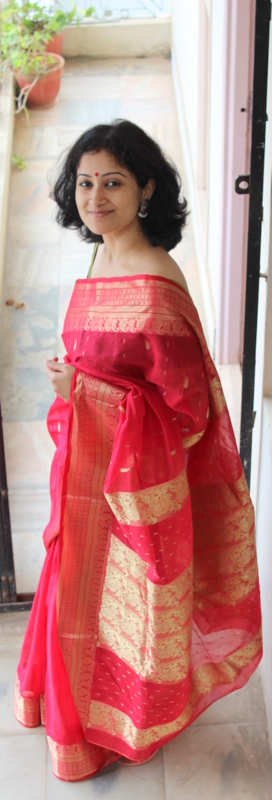Vermillion Hue
#18/100
The Soundarya Lahari written by Adi Shankara is not only a poem but a manual of tantras and shlokas. Verses 1 – 41 describe the mystical experience of the union of Shiva and Shakti and related phenomena and these are said to be the words of the Lord himself. These set of verses opens the assertion that Only when Shiva is united with Shakti does he have the power to create. Verses 42-100 are composed by Adi Shankara himself, which mainly focuses on the appearance of the Goddess. All the 100 verses are collectively known as ‘Soundarya Lahari’. In the second part there is a poem which beautifully describes the sindoor a woman wears. So I am adding that in the context of the vermillion tant saree I am wearing in the picture, which my mother gifted me.
Tanothu kshemam nas tava vadhana-saundarya lahari.
Parivaha-sthrotah-saraniriva seemantha-saranih.
Vahanti sinduram prabala-kabari-bhara-thimira-.
Dvisham brindair bandi-krtham iva navin’arka kiranam.
Translation – Oh mother, let the line parting thine hairs,
which looks like a channel,
through which the rushing waves of your beauty ebbs,
and which on both sides imprisons,
your Vermillion, which is like a rising sun,
by using your hair which is dark like
the platoon of soldiers of the enemy,
protect us and give us peace.
Vermillion on the other hand is a naturally available, highly toxic sulphide ore of mercury aka Cinnabar which had many uses including the Indian version of Sindoor which is a sign of fertility. It is therefore an integral part of Indian married women. The colour of Sindoor available in India ranges from different shades of red/vermillion to orange. However as Sindoor is really toxic, we have to use it caution! Even though the cosmetic powders may have some trace elements of cinnabar but those are made with lead compounds.

